Related Research Articles

The performing arts are arts such as music, dance, and drama which are performed for an audience. It is different from visual arts, which is when artists use paint, canvas or various materials to create physical or static art objects. Performing arts include a range of disciplines which are performed in front of a live audience, including theatre, music, and dance.

Rāmāyana is one of the two major Sanskrit epics of ancient India and important text of Hinduism, the other being the Mahābhārata.

Hanuman is a Hindu god and divine vanara companion of the god Rama. Hanuman is one of the central characters of the Hindu epic Ramayana. He is an ardent devotee of Rama and one of the chiranjivis. Hanuman is also son of the wind-god Vayu, who in several stories played a direct role in Hanuman's birth. Hanuman is mentioned in several other texts, such as the epic Mahabharata and the various Puranas.
The folklore of India encompasses the folklore of the nation of India and the Indian subcontinent. India is an ethnically and religiously diverse country. Given this diversity, it is difficult to generalize widely about the folklore of India as a unit.

Wayang, also known as wajang, is a traditional form of puppet theatre play originated on the Indonesian island of Java. Wayang refers to the entire dramatic show. Sometimes the leather puppet itself is referred to as wayang. Performances of wayang puppet theatre are accompanied by a gamelan orchestra in Java, and by gender wayang in Bali. The dramatic stories depict mythologies, such as episodes from the Hindu epics the Ramayana and the Mahabharata, as well as local adaptations of cultural legends. Traditionally, a wayang is played out in a ritualized midnight-to-dawn show by a dalang, an artist and spiritual leader; people watch the show from both sides of the screen.

Shadow play, also known as shadow puppetry, is an ancient form of storytelling and entertainment which uses flat articulated cut-out figures which are held between a source of light and a translucent screen or scrim. The cut-out shapes of the puppets sometimes include translucent color or other types of detailing. Various effects can be achieved by moving both the puppets and the light source. A talented puppeteer can make the figures appear to walk, dance, fight, nod and laugh.

Amar Chitra Katha, is an Indian publisher of graphic novels and comics. Most of them are based on religious legends and epics, historical figures and biographies, folktales and cultural stories. The company was founded in 1967 by Anant Pai.

Ashtavakra is a revered Vedic sage in Hinduism. His name literally means "eight bends", reflecting the eight physical handicaps he was born with. His maternal grandfather was the Vedic sage Aruni, his parents were both Vedic students at Aruni's school. Ashtavakra studied, became a sage and a celebrated character of the Hindu History(Itihas) Epics and Puranas.
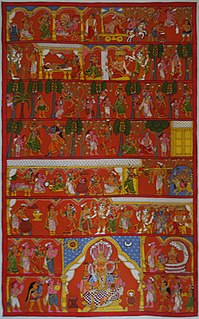
Cheriyal Scroll Painting is a stylized version of Nakashi art, rich in the local motifs peculiar to the Telangana. They are at present made only in Hyderabad, Telangana, India. The scrolls are painted in a narrative format, much like a film roll or a comic strip, depicting stories from Indian mythology, and intimately tied to the shorter stories from the Puranas and Epics. Earlier, these paintings were prevalent across Andhra, as also various other parts of the country, albeit flavoured with their distinct styles and other local peculiarities dictated by the local customs and traditions. In the same way, Cheriyal scrolls must have been popular across Telangana in earlier times, though with the advent of television, cinemas and computers it has been fenced into its last outpost, the Cheriyal town.

Pabuji Ki Phad is a religious scroll painting of folk deities, which is used for a musical rendition of the only surviving ancient traditional folk art form, Phad painting in the world of the epic of Pabuji, the Rathod Rajput chief. Bhopas of Pabusar are the bards and also priests who are the traditional narrators of this art form. The Phad is also spelt as “Par.” This art form is popular in the Indian state of Rajasthan. Literally, 'Pabuji Ki Phad' translates into two versions namely, "The Screen of Pabuji or O, Read of Pabuji!. Pabuji is also known as "the Ascetic Deity of Sand Desert".
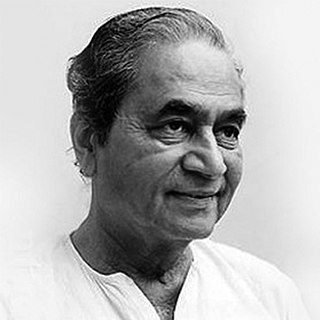
Badri Narayan was an artist, illustrator, author and story-teller.
Katha is an Indian style of religious storytelling, performances of which are a ritual event in Hinduism. It often involves priest-narrators who recite stories from Hindu religious texts, such as the Puranas, the Ramayana or Bhagavata Purana, followed by a commentary (Pravachan). Kathas sometimes take place in households, involving smaller stories related to the Vrat Katha genre. The didactic Shri Satyanarayan and Ramayana kathas instill moral values by revealing the consequences of human action (karma).

Depending on the methods of counting, as many as three hundred versions of the
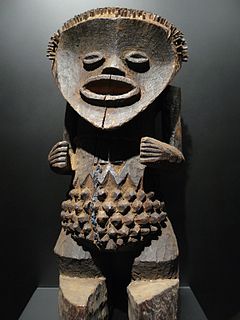
Tribal art is the visual arts and material culture of indigenous peoples. Also known as non-Western art or ethnographic art, or, controversially, primitive art, tribal arts have historically been collected by Western anthropologists, private collectors, and museums, particularly ethnographic and natural history museums. The term "primitive" is criticized as being Eurocentric and pejorative.

Patachitra or Pattachitra is a general term for traditional, cloth-based scroll painting, based in the eastern Indian states of Odisha and West Bengal. Patachitra artform is known for its intricate details as well as mythological narratives and folktales inscribed in it. Pattachitra is one of the ancient artworks of Odisha, originally created for ritual use and as souvenirs for pilgrims to Puri, as well as other temples in Odisha. Patachitras are a component of an ancient Bengali narrative art, originally serving as a visual device during the performance of a song.
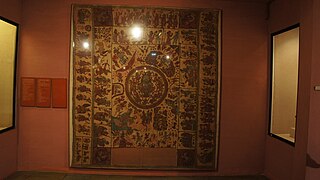
Kalamkari is a type of hand-painted or block-printed cotton textile produced in Isfahan, Iran, and in the Indian state of Andhra Pradesh. Only natural dyes are used in Kalamkari, which involves twenty-three steps.
It is not easy to trace out the origins of the Telugu folk literature, for that matter any folk literature. It is as difficult as tracing the origin of a language. In other words, one can argue that the origin and existence of any folk literature can be a parallel phenomenon along with that language, because the folk expressive traditions of any ethnic group are much earlier than the language of that particular ethnic group. Need not say about the developed literature in written tradition. The cave paintings and line drawings found in different archeological sites prove the ability of the creative expressions of prehistoric human beings even before they were not able to speak. The addition of verbal creativity in latter periods has widened the folk expressive tradition in another medium that is verbal folk arts or the folk literature. Therefore, the existence of any folk literature can go back to the time of the given language correspondingly.
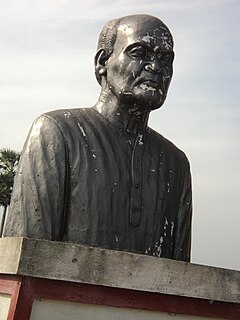
Vaddadi Papaiah (1921–1992), name sometimes spelt Papayya, pen-name Vapa, was a painter and illustrator for Telugu magazines, known especially for his covers for the children's magazine Chandamama.
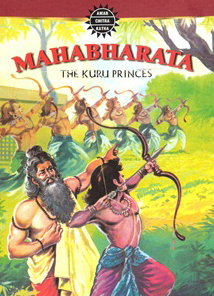
Mahabharata is a comic adaptation of the Indian epic poem Mahabharata. The 42-issue best-selling series by Amar Chitra Katha, Mumbai was illustrated by Dilip Kadam. The team of script writers included Kamala Chandrakant, TMP Nedungadi, Subba Rao, Yagya Sharma, Lopamudra, Mihir Lal Mitra, Sumona Roy, Mohan Swaminathan, Shubha Kandhekar and Margie Sastry.
Saura tribal painting is a style of wall mural paintings associated with the Saura tribals of the state of Odisha in India. These paintings, also called ikons are visually similar to Warli paintings and hold religious significance for the Sauras. In recent years they have seen a rise in popularity and have appeared as decorative icons on items such as t-shirts, mugs and diaries.
References
- ↑ "Chitrakathi Paintings". Archived from the original on 2016-04-27. Retrieved 2016-04-18.
- 1 2 "Reviving a dying art form with visuals of another | Chennai News - Times of India". The Times of India. Retrieved Nov 24, 2020.
- ↑ "Chitrakathi | Art". www.konkanonline.com. Retrieved Nov 24, 2020.
- ↑ "Archive News". The Hindu. Retrieved Nov 24, 2020.